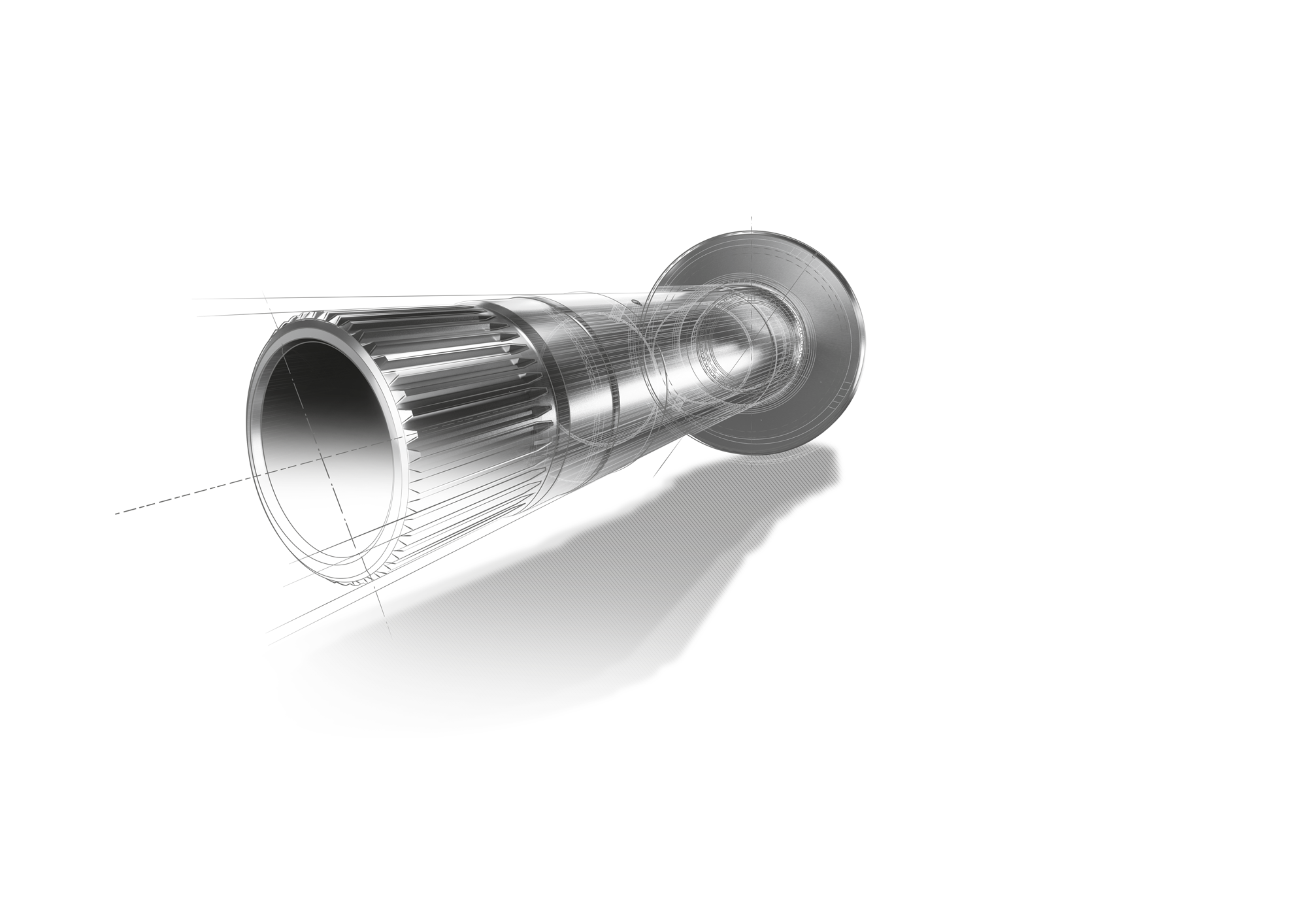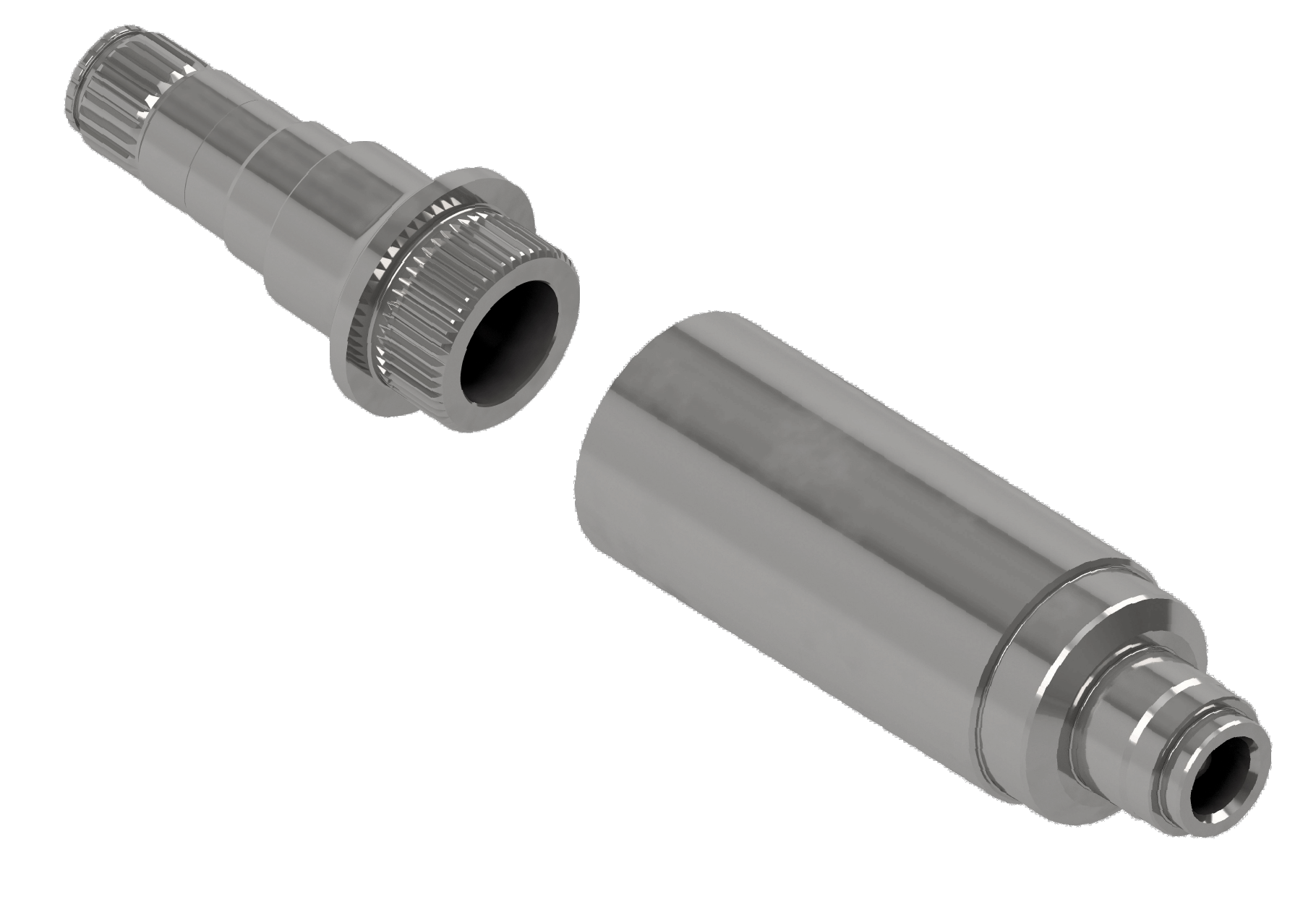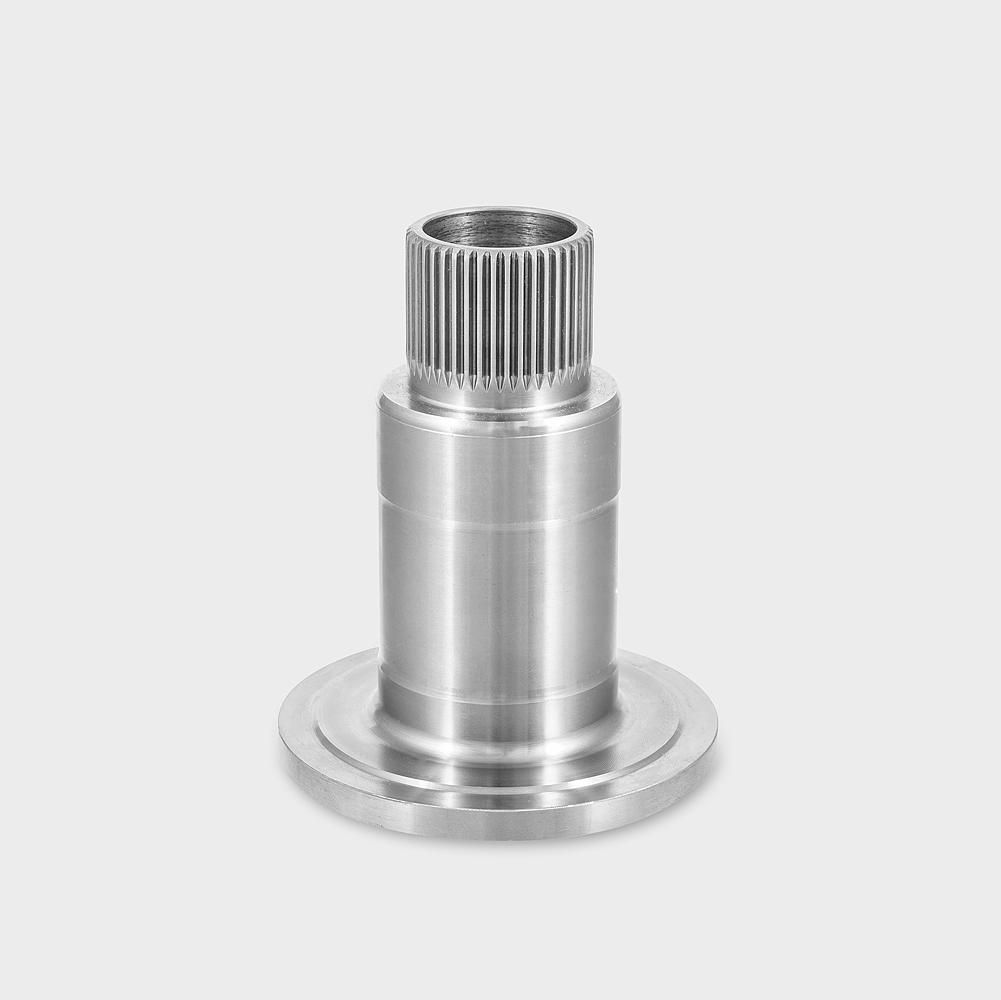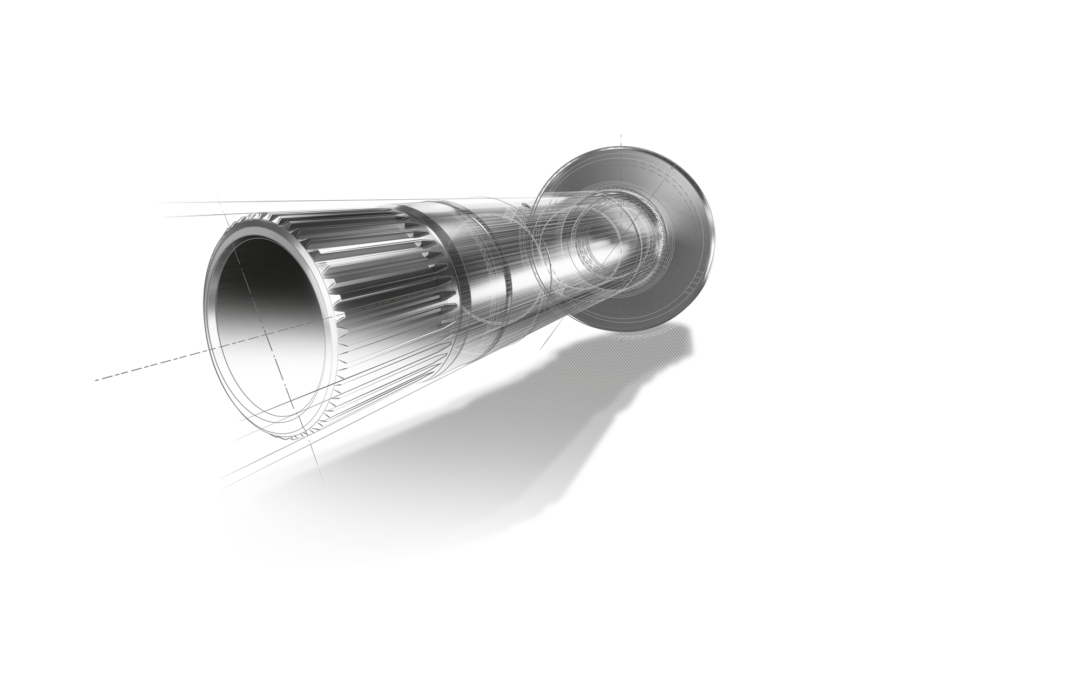Involute spline

Nicolas Heck
Published
Involute splines: Briefly explained
Involute toothing is a specific type of toothing that is defined by the shape of the tooth flanks. It therefore refers to the geometric shape of the teeth of a gearwheel. Instead of a straight tooth shape, as you might be familiar with from a saw, the teeth of an involute spline have a curved shape, which means that when gears with involute splines are in use, they mesh well and rotate smoothly without chattering or jamming.

Why are involute splines so suitable for gearing?
An involute is a geometric curve. It is created when a so-called rolling straight line is unrolled on a base circle. The resulting curve determines the shape of the involute, which becomes less and less curved the longer it gets. This means that it becomes flatter and flatter the further it moves away from the base circle.
This can be visualized by unwinding a tightly held thread from a round object. It is important that the rope is kept very taut when unwinding. The diameter of the object is the base circle of the involute and the end of the thread describes the shape of the circular involute. The curvature of the involute corresponds to the arc length on the base circle.
The geometric properties and their advantages for gears
These properties make the involute ideal for the design of teeth in gear teeth, as this shape ensures a smooth transition between the teeth and results in the force being transmitted evenly. These geometric properties of the involute result in an orthogonal curve when two involutes intersect. As a result, the forces are evenly distributed along the contact line of the tooth flanks, which in turn leads to optimum power transmission and minimal friction. As a result, involute toothing helps to ensure that the teeth of a gear mesh evenly and efficiently and that the torque is transmitted evenly.
Involute splines: Component production at Felss
We use axial forming for the production of splined shafts and splines with involute profiles. This technology makes it possible to produce high-precision gearing components economically by implementing gearing dimensions exactly – without any pitch errors, as the teeth are an exact copy of the tool. This process increases the quality and material strength and thus the fatigue strength of the components, while at the same time ensuring fast production and efficient use of resources.
From the drawing to the finished component, we at Felss stand for our expertise in cold forming. Our specialized processes enable us to produce a wide range of components efficiently and with the highest precision, allowing us to meet the specific requirements of our customers. Our focus is on optimizing component properties, the use of materials and improving material strength, which not only increases the quality and durability of the products, but also leads to a significant reduction in production costs.
Splines with involute flanks
Splines are a special form of gearing that is used in a variety of mechanical applications to enable modular, flexible and space-saving connections between different components of a system. Unlike splines, which are designed for permanent, continuous power transmission in constantly meshing systems, splines offer the possibility of quick assembly and disassembly, making them particularly valuable for applications that require regular maintenance, adjustment or replacement of parts. They also offer the option of a particularly compact design.
Splines with involute profile: modularity and flexibility
Splines with involute flanks represent a specialized category of splines that combine the precision and efficiency of involute geometry with the flexibility of separable connections. This type of gearing is particularly valuable in applications that require both precise power transmission and the ability to disassemble and assemble quickly.
Where are splines with involute profiles used?
The involute shape ensures optimum power transmission through uniform contact along the entire contact line, resulting in efficient and quieter performance. Their applications range from high-precision medical devices and modular robotic systems to vehicle components, where flexibility is required without compromising on transmission accuracy. Thanks to this combination of precision and modularity, involute splines offer innovative solutions for a wide range of technical challenges. In the automotive industry, involute splines are used as splined shafts in steering systems and gearboxes, thus guaranteeing efficient torque transmission
What makes gears with involute splines special?
A key feature of involute profiles on running gears is their frictionless engagement, which is made possible by the specific geometry of the tooth flanks. The common normal of the two tooth profiles, which specifies the direction of the contact force between the gears, always passes through the so-called rolling point at every possible point of contact. The rolling point is the intersection of the extensions of the axes of the two gears. This ensures uniform power transmission along the contact line of the tooth flanks.
Even force distribution and constant angle of rotation transmission
This even distribution of force contributes to the stability and longevity of the systems by avoiding excessive stress on individual teeth. In addition, the pitch point divides the connecting line between the pivot points of the two gears in the inverse ratio of the angular velocities. This is crucial for the transmission of torque between the gears and ensures smooth, quiet running during operation. Precise motion transmission allows movements to be executed accurately and repeatably, resulting in efficient and reliable operation while minimizing wear and noise.

Involute splines: Functional for center distance changes
In addition, involute splines are characterized by their high tolerance to changes in the centre distance of the gears. This allows it to be flexibly adjusted without having a significant impact on the overlap and smooth running. Smooth engagement and precise power transmission are characteristic features of involute splines that contribute to their widespread use in various industrial applications.
Basics of involute gearing
The design of involute splines is based on precise geometric and physical principles that are crucial for their functionality. A central element of this is the law of gearing, which provides for uniform torque transmission through the specific design of the tooth flanks. It ensures that the tooth flanks are formed according to the shape of an involute derived from a circle. This enables efficient motion transfer between components by promoting continuous rolling motion without sliding, which ensures consistent angular velocity translation.
Influence of the base circle
The base circle diameter plays an important role in the design of involute splines and has a direct effect on the shape of the tooth flanks if the module is kept constant. With a constant module – a dimension that determines the tooth size in relation to the pitch circle diameter – a larger base circle diameter leads to flatter tooth flanks, while a smaller base circle diameter leads to steeper tooth flanks

Determination of the pitch circle diameter
Determining the pitch circle diameter is a crucial step in the design process. This is calculated as the product of the module and the number of teeth. The module determines the size and distance between the teeth. The pitch circle serves as a reference for further calculations and design processes.
Determination of the pressure angle
The pressure angle, usually set at 20° as standard, is another important factor. It defines the angle between the meshing line of two teeth and the normal of the center line. The choice of pressure angle is crucial, as it not only determines the geometric interaction between the tooth flanks, but also influences the operating characteristics of the gearing, such as load capacity, wear behavior and noise development. A larger pressure angle can increase the robustness of the tooth flanks and enables improved load distribution, which is particularly advantageous in applications with high loads. However, this can also lead to an increase in axial forces, which places additional demands on the bearings and the design of the entire system.
Profile shift for optimization
Another aspect of the design of involute splines is the profile shift. The tooth profiles are shifted along the involute without changing the base circle diameter. This shift leads to a flatter curvature of the tooth flank, improves the distribution of contact forces and thus increases the service life and performance of the gearing.
Calculation of the intervention division
The meshing pitch refers to the distance between two tooth flanks in contact and is decisive for uniform flank contact. Correct calculation of the meshing pitch ensures efficient power transmission and minimizes wear on the gears. Ensuring constant and even contact between the tooth flanks prevents punctual loads and the associated wear.

Conclusion
Due to their high quality, precision and reliable transmission capability, involute splines are an outstanding choice for demanding mechanical applications. They are also characterized by remarkably smooth running and wear resistance, which underlines their durability and reliability. The axial forming process plays a decisive role in this by ensuring not only the high and consistent quality of these gears, but also their material and fatigue strength. At the same time, it enables economical and resource-efficient production, making involute splines an optimal solution for efficient and sustainable manufacturing processes.
Questions about gearing?
Do you have questions about our products and services and would like to find out more about Felss? Then do not hesitate to contact us! Our experts will be happy to advise you.

Come to us as early as the development phase of your projects
We support you throughout the entire process – from the drawing to the finished component and beyond.
